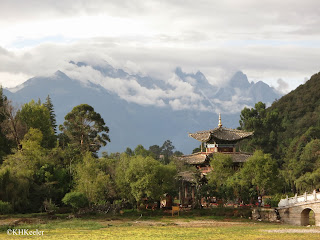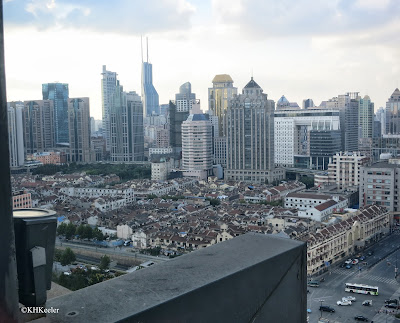 |
| downtown Beijing |
In September I took a tour of China with the Denver Art Museum's Asian Art Association, coordiated by Access China Tours. We went from Beijing to Dunhuang in the west through Xian and Chengdu in central China to Lijiang and Dali in the far southwest (Yunnan Province) ending in Shanghai. The contrasts are staggering and I am trying to organize what I saw. We tend to talk about "going to --" as if landing in the capital or the top tourist location will show you all the place has to offer. It is not that easy!
In US terms, our trip was like seeing New York City and Washington D.C., the countryside near Atlanta, Georgia and Biloxi, Mississippi, as well as visiting Taos, New Mexico...different in levels of urbanness, climate, history, ethnic mixes...
 |
| Dunhuang dunes |
Beijing is "China"...As the capital most tours go there. The traffic was pretty continually snarled and the air gray. That said, the Forbidden City (a quaint old name, in modern Chinese the name is the Former Palace), Tiananmen Square, the art museums and the Great Wall are all well worth seeing. In September, it was warm and relatively humid.
Dunhuang, in Gansu Province,
is about 1500 miles (2,438 km ) west of Beijing, on the edge of the Gobi Desert. It was dry! Days were hot and nights very cool. Great sand dunes loomed above the town. An important trading area, the people were and are a mix of races and ethnic groups. A small place with a long interesting history.
 |
| Tang Dynasty tomb, Xian |
From there we flew south and east. There was no direct flight to our destination, Chengdu in Sichuan Province, so we stopped briefly in Xian. Xian is rightly famous for the terra cotta army of the first emperor, Qin Shi Huangdi. A remarkable megalomanic, he unified small states creating an empire that lasted 2000 years, gave China a single currency, streamlined communications, built defensive walls, burned books, massacred intellectuals and built a no-expense-spared tomb. However, Xian was not only his capital but the capital of the Han, Sui, Tang Dynasties, among others. Beijing has only been China's capital relatively recently. Xian was also the eastern end of the great trade route, the Silk Road. We stopped at a Tang Dynasty tomb and museum.
 |
| pandas in Chengdu |
From there we visited Chengdu in Sichuan. It was very humid and continually overcast. And green, with lots of plants--a stark contrast with Dunhuang. Chengdu hosts a large panda breeding center, a must for tourists. The pandas were basically in a zoo, but a luxurious one. Like Xian, Chengdu is central to Chinese history. We visited the Sanxingdui Museum, which houses a rich collection of Neolithic and pre-Han artifacts (7000 BC to 700 BC)--curious, interesting and reminding us of the antiquity of Chinese culture.
 |
Shu mask, Sanxingdui Museum
more than 1000 BC |
 |
| Jade Dragon Snow Mountain from Lijiang |
From Chengdu we went south and west, to Lijiang in Yunnan Province. Lijiang is at 8000' but not considered in the Himalayas. It is far enough south that despite the elevation it only gets snow every few years and bouganvillias and other frost-intolerant plants grow well there. Traditionally it was trading city, where Chinese and Tibetans met. All of Yunnan Province is rich in non-Han-Chinese ethnic groups, some still in their ancestral areas, some much more widely distributed.
 |
| Mixed forest, Jade Dragon Snow Mountain, Yunnan |
Jade Dragon Snow Mountain rises above Lijiang to over 18000'. On it is the southernmost glacier in the Northern Hemisphere, the source of water for Lijiang and surroundings and of concern as the glacier retreats.
We took the gondola to Yak Meadow, at about 10,000'. The yaks were away. Even that high the plants were numerous and diverse. At elevations where the Rocky Mountains have much simpler forests of mainly pine and spruce, Jade Dragon Snow Mountain had many different broad-leaved trees and vines as well as pines. A fascinating ecosystem!
 |
| Rice in Dali, Yunnan, Chi |
Dali, farther south in Yunnan, is lower in elevation. We got there as the rice in the paddies was nearly ready to harvest. It is a pretty area, set along Erhai, one of China's largest lakes. It has been too remote for most visitors, but better transportation, both roads and airports, is letting it develop, with all the good and bad aspects of that.
Chengdu is a city of some 14 million...Dali half a million. So Dali is relatively small, rural and agricultural.
 |
| Shore of Erhai Lake, Dali |
 |
Shanghai
|
Then we flew to Shanghai, very much a 21st century city.
 |
| Shanghai, looking a different direction |
Shanghai's population was over 23 million in 2010, making it the largest city in the world. It will only have grown since. Shanghai is proud of being spectacularly ultramodern. Towering buildings in every direction. The architecture is impressive--lots of glass and steel. At night the buildings are lit with shining, moving neon displays.
How do I pull all of that diversity together?
The China I saw was modern -- internet and cell phones, superhighways, bullet trains -- with modern problems such as traffic gridlock, air pollution and unsafe consumer goods to solve. At the same time, China has thousands of years of history setting traditions, customs and infrastructure, some of that helpful in the 21st century, some of that problematic. And diverse! Wet to dry, warm to cold, sea level to over 10,000'. As a result, the south grows rice, the north grows corn (historically millet). Some places they get three crops a year, other places just one. In the deserts, nothing grows unless it is irrigated.
The people are no less diverse. The government recognizes 55 official minority groups. In Lijiang our guide was Naxi, the dominant group there, and she recognized several significant Naxi subgroups, so 55 is a minimum number of minorities. The small glimpse we got in Dunhuang, Lijiang and Dali included different costumes, different favorite holidays, different local economies...all kinds of differences.
The books I read tended to make simple assertions about China--but the China I saw is difficult to summarize.
And it seems likely that you would want to say that about any country--it is so much more than its capital and most recognizable monument.
Comments and corrections welcome.
Kathy Keeler, A Wandering Botanist











I will fell lucky when i can able to visit Beijing..
ReplyDeletebeijing tours
A very good and informative article indeed. It helps me a lot to enhance my knowledge, I really like the way the writer presented his views.
ReplyDeleteBeijing tour package